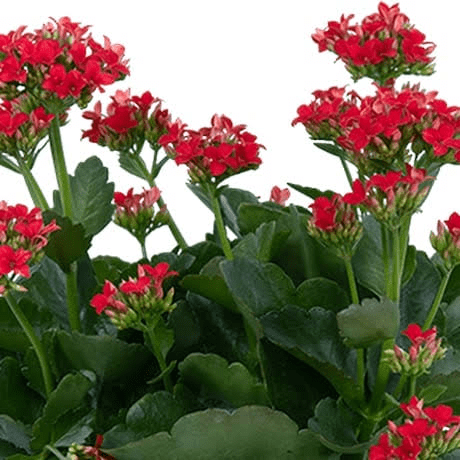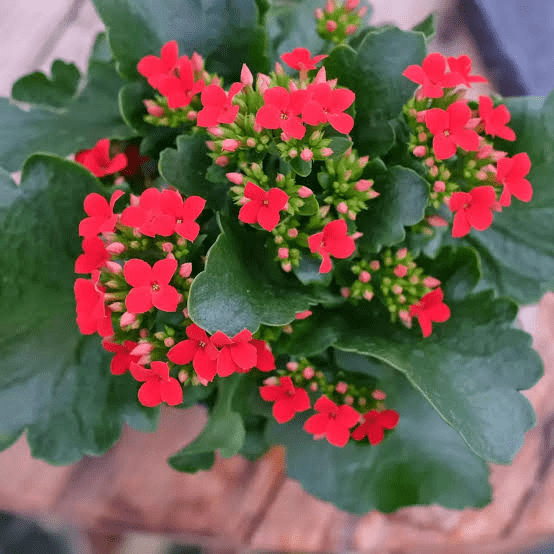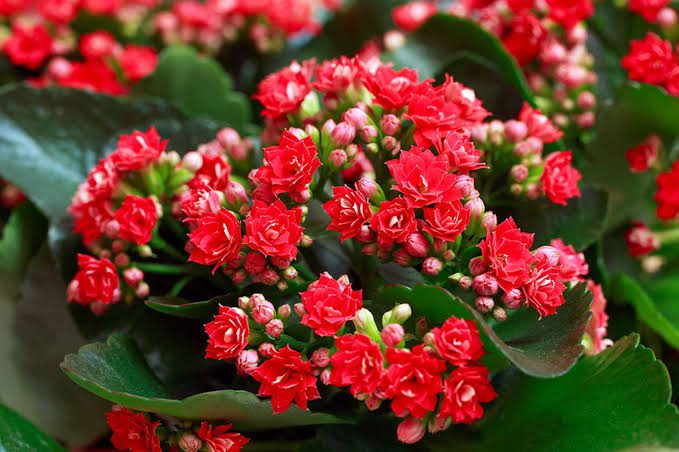Kalanchoe, commonly referred to as Mother of Thousands is a remarkable plant known for its extensive medicinal properties. This article discusses the diverse health benefits offered by Kalanchoe and explores its historical use as a potent healing agent.
The use of Kalanchoe in traditional medicine can be traced back through the ages. Indigenous communities in various parts of the world have harnessed its therapeutic potential for a wide range of ailments. Let’s embark on a journey through time to uncover the historical significance of Kalanchoe in the realm of herbal medicine.
The Botanical Description of Kalanchoe
Kalanchoe is a fascinating succulent plant known for its unique botanical characteristics. Here, we’ll list and explain seven key aspects of its botanical description:
1. Taxonomic Classification: Kalanchoe belongs to the family Crassulaceae, and its scientific classification includes:
- Kingdom: Plantae
- Phylum: Angiosperms
- Class: Eudicots
- Order: Saxifragales
- Family: Crassulaceae
- Genus: Kalanchoe
2. Morphological Features: Kalanchoe exhibits a diverse range of species, but common features include succulent leaves, often with a waxy coating, and the ability to propagate via plantlets on the leaf margins.
3. Leaf Arrangement: The leaves are typically arranged in a rosette pattern, forming a visually striking and distinctive appearance.
4. Leaf Variability: Leaves can vary in shape, size, and color depending on the species. They may be lance-shaped, paddle-like, or rounded, with colors ranging from deep green to vibrant red or purple.
5. Flowers: Kalanchoe produces colorful, tubular flowers in various shades, including red, orange, yellow, and pink. These blooms are visually appealing and attract pollinators.
6. Native Habitat: Kalanchoe is native to a range of regions, including Africa, Madagascar, and parts of Asia. It has adapted to diverse ecosystems, from arid deserts to tropical rainforests.
7. Growth Habit: The growth habit of Kalanchoe can vary from low, spreading ground covers to tall, upright shrubs. Some species remain compact, while others can become sizeable over time.
The Geographic Distribution of Kalanchoe
Kalanchoe is a widespread succulent genus with a diverse geographic distribution. Here, we’ll list and explain seven key aspects of its distribution:
1. Native Range: Kalanchoe is native to various regions, including parts of Africa, Madagascar, and Asia. It thrives in a range of climates, from arid to subtropical.
2. African Diversity: The African continent is a significant center of diversity for Kalanchoe species. Many different species can be found across Africa, adapted to various ecological niches.
3. Madagascar Endemism: Madagascar, known for its rich biodiversity, is home to several Kalanchoe species that are endemic to the island. These species have evolved in isolation and exhibit unique traits.
4. Asian Presence: In Asia, particularly in countries like India and China, Kalanchoe species can be found in diverse habitats, including rocky outcrops and forested areas.
5. Global Adaptation: Kalanchoe’s adaptability has allowed it to be cultivated and naturalized in many parts of the world, including Europe, the Americas, and Australia.
6. Urban Landscaping: In addition to its natural habitat, Kalanchoe is often used in urban landscaping, adding ornamental value to gardens and public spaces.
7. Greenhouse Cultivation: Due to its popularity as a houseplant, Kalanchoe is also grown in greenhouses in regions where outdoor cultivation is challenging.
The Chemical Composition of Kalanchoe
The chemical composition of Kalanchoe contributes to its medicinal properties. Here, we’ll list and explain eight key components found in Kalanchoe:
1. Flavonoids: Kalanchoe contains flavonoids, such as quercetin and kaempferol, known for their antioxidant and anti-inflammatory properties.
2. Alkaloids: Certain Kalanchoe species produce alkaloids, which may have analgesic and cytotoxic effects.
3. Triterpenoids: Triterpenoids found in Kalanchoe exhibit potential anti-inflammatory and anticancer activities.
4. Glycosides: Some species contain glycosides that may contribute to cardiovascular health and blood pressure regulation.
5. Organic Acids: Organic acids like malic and citric acid are present, lending tartness to the taste and contributing to its potential as a digestive aid.
6. Phenolic Compounds: Phenolic compounds, including phenolic acids and polyphenols, may contribute to antioxidant and anti-inflammatory effects.
7. Bufadienolides: Certain species contain bufadienolides, which have been studied for their potential anticancer properties.
8. Essential Oils: Essential oils extracted from Kalanchoe species may contain various compounds contributing to their aromatic and therapeutic qualities.
The Cultivation and Growth of Kalanchoe
Cultivating and growing Kalanchoe can be a rewarding endeavor, given its resilience and ornamental value. Here, we’ll list and explain six key aspects of its cultivation and growth:
1. Soil Requirements: Kalanchoe thrives in well-drained soil with good aeration. A cactus or succulent potting mix is often suitable.
2. Sunlight Needs: This plant prefers bright, indirect sunlight, making it well-suited for windowsills or outdoor gardens with partial shade.
3. Watering Guidelines: Kalanchoe prefers moderate watering. Allow the soil to dry slightly between waterings to prevent root rot.
4. Propagation Methods: Kalanchoe can be propagated from stem or leaf cuttings, and some species produce offsets or “pups.”
5. Pruning and Maintenance: Regular pruning can help maintain the plant’s shape and encourage bushier growth. Remove spent flower stalks to promote new blooms.
6. Pest and Disease Resistance: Kalanchoe is generally resistant to pests and diseases. However, watch for common succulent pests like mealybugs and aphids.
The Harvesting and Processing of Kalanchoe
Harvesting and processing Kalanchoe involve specific steps to maximize its medicinal potential. Here, we’ll list and explain eight key aspects of these processes:
1. Harvesting Time: For medicinal purposes, Kalanchoe leaves are typically harvested when mature and healthy. Select leaves that are free from damage or disease.
2. Leaf Collection: Use clean, sharp scissors or pruning shears to cut the leaves close to the stem. Avoid damaging the plant during the process.
3. Drying: Harvested leaves are often air-dried in a well-ventilated area away from direct sunlight to preserve their beneficial compounds.
4. Processing for Extracts: To extract specific compounds, such as essential oils or active phytochemicals, leaves may undergo various extraction methods like steam distillation or solvent extraction.
5. Formulation: Processed extracts can be formulated into different medicinal products, including ointments, creams, tinctures, or herbal teas.
6. Quality Control: Rigorous quality control measures are essential to ensure the final product meets safety and efficacy standards.
7. Traditional vs. Modern Processing: In traditional medicine systems, Kalanchoe may undergo specific processing techniques unique to local customs and practices.
8. Storage: Store harvested leaves, extracts, or processed products in airtight containers in a cool, dark place to maintain their quality.
Read Also: Process of Composting Organic Waste Materials
The Medicinal Health Benefits Of Kalanchoe (Mother of Thousands)

Kalanchoe, commonly known as Mother of Thousands, possesses an array of remarkable medicinal health benefits. Here, we’ll list and explain 19 key health advantages associated with this versatile plant:
1. Wound Healing: Kalanchoe’s leaves have been used topically to promote wound healing and tissue repair.
2. Anti-Inflammatory: It exhibits anti-inflammatory properties, making it effective for soothing inflamed skin or joints.
3. Antioxidant Action: Kalanchoe is rich in antioxidants that combat free radicals, reducing oxidative stress.
4. Pain Relief: It may help alleviate various types of pain, including headaches and muscle aches.
5. Skin Health: Kalanchoe is used to treat skin conditions like burns, rashes, and insect bites.
6. Immune Support: Some compounds in Kalanchoe can enhance the immune system’s response to infections.
7. Digestive Aid: It has been traditionally used to relieve digestive discomfort, including indigestion.
8. Respiratory Health: Kalanchoe may help alleviate respiratory conditions such as coughs and bronchitis.
9. Cardiovascular Health: Some studies suggest that it may contribute to heart health by regulating blood pressure and cholesterol levels.
10. Anti-Anxiety: The plant’s aroma, when used in aromatherapy, may have calming effects and reduce anxiety.
11. Anti-Microbial: Kalanchoe exhibits antimicrobial properties that can be effective against infections.
12. Anti-Allergic: It may help mitigate allergic reactions by reducing histamine release.
13. Anti-Diabetic: Research indicates potential benefits in managing diabetes and regulating blood sugar levels.
14. Anticancer Properties: Some studies have explored its potential in cancer prevention and treatment.
15. Gastrointestinal Health: Kalanchoe supports gastrointestinal health by aiding digestion and reducing inflammation.
16. Bone Health: It contains compounds that may contribute to bone health and prevent osteoporosis.
17. Weight Management: Kalanchoe has been studied for its potential role in weight management and obesity prevention.
18. Liver Health: It may assist in detoxifying the liver and improving its overall function.
19. Anti-Aging: The plant’s antioxidants may help combat the signs of aging by reducing oxidative damage to skin cells.
The Methods of Usage to Achieve the Provided Health Benefits Of Kalanchoe (Mother of Thousands)
To harness the health benefits of Kalanchoe, various methods of usage have been employed. Here, we’ll list and explain eight common methods:
1. Topical Application: Kalanchoe extracts or gel can be applied directly to the skin to address skin issues, wounds, or inflammation.
2. Herbal Tea: Dried Kalanchoe leaves can be used to prepare herbal tea, offering digestive and immune-boosting benefits.
3. Essential Oil: Essential oil extracted from Kalanchoe can be diluted and used for aromatherapy or applied topically.
4. Tinctures: Tinctures, made from Kalanchoe leaves and alcohol, are taken orally for their medicinal effects.
5. Poultices: Crushed Kalanchoe leaves can be applied as poultices on wounds or skin irritations.
6. Inhalation: Aromatherapy using Kalanchoe essential oil can help with respiratory and stress-related issues.
7. Dietary Supplement: Kalanchoe supplements, available in various forms, can be taken as part of a daily health regimen.
8. Traditional Remedies: In some cultures, traditional herbal preparations using Kalanchoe are still employed for various health concerns.
The Side Effects Of Using Kalanchoe Medicinal Plant
While Kalanchoe offers numerous health benefits, it’s important to be aware of potential side effects. Here, we’ll list and explain seven side effects associated with the use of Kalanchoe:
1. Skin Irritation: Some individuals may experience skin irritation or allergies when using Kalanchoe topically.
2. Gastrointestinal Distress: Overconsumption of Kalanchoe tea or extracts may lead to gastrointestinal discomfort, including nausea and diarrhea.
3. Photosensitivity: Applying Kalanchoe gel or oil to the skin and then exposing it to sunlight may increase the risk of sunburn.
4. Allergic Reactions: Allergic responses to Kalanchoe, though rare, can include itching, redness, or swelling.
5. Pregnancy and Breastfeeding: Pregnant or breastfeeding individuals should exercise caution and consult a healthcare provider before using Kalanchoe due to limited safety data.
6. Medication Interactions: Kalanchoe may interact with certain medications, so individuals on medication should consult a healthcare professional before use.
7. Overuse: As with any herbal remedy, overuse or excessive consumption can lead to adverse effects. Moderation is key.
Read Also: 17 Medicinal Health Benefits Of Boswellia sacra (Frankincense)
Scientific Research and Studies of Kalanchoe (Mother of Thousands)

Scientific research and studies have contributed significantly to our understanding of Kalanchoe’s potential benefits and safety. Here, we’ll list and explain six key areas of scientific investigation:
1. Anticancer Properties: Studies have explored Kalanchoe’s potential in cancer treatment, particularly in suppressing tumor growth.
2. Wound Healing: Research has focused on its ability to accelerate wound healing and tissue regeneration.
3. Anti-Inflammatory Effects: Investigations have assessed the anti-inflammatory properties of Kalanchoe and their potential applications.
4. Antioxidant Activity: Studies have quantified the antioxidant capacity of Kalanchoe, highlighting its role in reducing oxidative stress.
5. Antimicrobial Action: Research has examined Kalanchoe’s effectiveness against various pathogens, contributing to its antimicrobial potential.
6. Safety Profiles: Studies have evaluated the safety of Kalanchoe, including potential side effects and toxicity levels.
The Safety Precautions and Recommendations In Using Kalanchoe (Mother of Thousands) Medicinal Plant
When using Kalanchoe for its medicinal properties, it’s important to exercise caution and follow safety recommendations. Here, we’ll list and explain seven safety precautions and recommendations:
1. Allergy Testing: Before widespread use, perform an allergy test by applying a small amount of Kalanchoe extract or gel to a patch of skin. If any adverse reactions occur, discontinue use.
2. Dosage Guidelines: Adhere to recommended dosage guidelines to avoid overconsumption, which can lead to adverse effects.
3. Consultation with Healthcare Provider: If you are pregnant, breastfeeding, or have underlying medical conditions, consult a healthcare provider before using Kalanchoe to ensure it is safe for your specific situation.
4. Medication Interactions: Be aware of potential interactions between Kalanchoe and medications you may be taking. Consult a healthcare professional if you are unsure about compatibility.
5. Sun Exposure: If using Kalanchoe gel or oil topically, be cautious about sun exposure afterward, as it may increase the risk of sunburn.
6. Safe Storage: Store Kalanchoe products, such as extracts or oils, out of reach of children and pets. Follow storage instructions to maintain their quality and safety.
7. Moderation: As with any herbal remedy, using Kalanchoe in moderation is essential to prevent adverse effects. Follow recommended usage guidelines.
The Legal Status and Regulations In Using Kalanchoe (Mother of Thousands) Medicinal Plant
The legal status and regulations regarding the use of Kalanchoe can vary by region. Here, we’ll list and explain six common aspects related to its legal status and regulations:
1. Herbal Supplement Regulations: Kalanchoe is often sold as an herbal supplement, and its sale may be subject to regulations governing dietary supplements in your country.
2. Cultivation and Harvesting Laws: In some regions, there may be specific laws and regulations governing the cultivation and harvesting of Kalanchoe and other medicinal plants.
3. Import and Export Regulations: If Kalanchoe or its products are being imported or exported, compliance with international trade and phytosanitary regulations is crucial.
4. Traditional Medicine Use: In areas where traditional medicine is practiced, there may be specific regulations governing the use of Kalanchoe in traditional healing practices.
5. Herbal Products Labeling: Laws may require accurate labeling of Kalanchoe products, including ingredient lists and health claims.
6. Safety and Quality Standards: Regulations may dictate safety and quality standards for Kalanchoe products, including testing for contaminants.
FAQs About Kalanchoe (Mother of Thousands) Medicinal Plant
Here, we’ll list and explain 16 frequently asked questions (FAQs) about Kalanchoe to provide comprehensive information:
1. What is Kalanchoe?
Kalanchoe, also known as Mother of Thousands is a medicinal succulent plant with various health benefits.
2. How can I use Kalanchoe for wound healing?
Apply Kalanchoe gel or oil topically to wounds for its healing properties.
3. Is Kalanchoe safe for topical use on skin irritations?
In most cases, yes, but perform a patch test to check for allergies or sensitivity.
4. Can I ingest Kalanchoe for its health benefits?
Yes, Kalanchoe can be consumed as herbal tea or dietary supplements, following recommended guidelines.
5. Is Kalanchoe safe during pregnancy and breastfeeding?
Consult a healthcare provider before using Kalanchoe if pregnant or breastfeeding.
6. Are there any side effects of using Kalanchoe?
Possible side effects include skin irritation, allergies, and gastrointestinal discomfort with excessive consumption.
7. How do I store Kalanchoe products?
Store them in a cool, dark place, following the manufacturer’s instructions.
8. Can Kalanchoe interact with medications?
It may interact with certain medications, so consult a healthcare professional if you are on medication.
9. Is Kalanchoe protected by intellectual property rights?
Protection of intellectual property rights may apply to commercialized Kalanchoe products, especially if patented or trademarked.
10. Can I grow Kalanchoe at home?
Yes, Kalanchoe is suitable for home cultivation in well-drained soil with adequate sunlight.
11. How can I make Kalanchoe tea?
To make Kalanchoe tea, steep dried leaves in hot water for several minutes.
12. Is Kalanchoe effective against respiratory issues?
It may help alleviate respiratory conditions like coughs when used as a remedy.
13. Is there scientific research on Kalanchoe’s health benefits?
Yes, ongoing research explores its potential benefits and safety, contributing to our understanding of this medicinal plant.
14. What is the recommended dosage of Kalanchoe supplements?
Dosage recommendations can vary, so follow the instructions on the product label or consult a healthcare provider.
15. Can Kalanchoe be used for stress relief?
Inhaling the aroma of Kalanchoe essential oil through aromatherapy may help reduce stress and anxiety.
16. Are there any age restrictions for using Kalanchoe products?
Products should be used according to age-appropriate guidelines and dosage recommendations, especially for children and the elderly.
Read Also: Definition of Environmental Safety: A Comprehensive Guide

